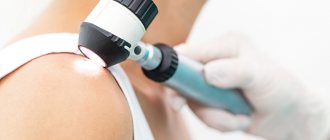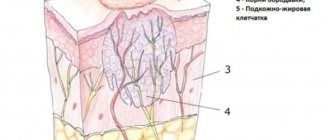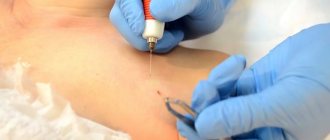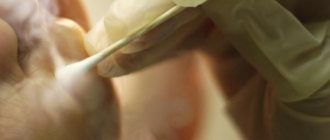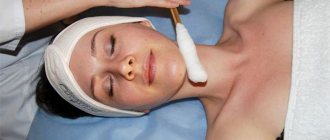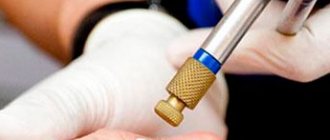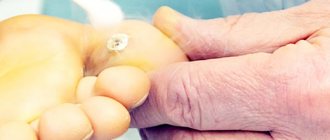An infectious or viral pathogen can easily penetrate into the bloodstream through an injured mole; also, trauma to a nevus is often accompanied by hemorrhage. In addition, there is a risk of a healthy mole degenerating into a pathological neoplasm, so it is better to get rid of some nevi in advance. Since the use of liquid nitrogen practically does not provoke the formation of scars and cicatrices, the removal of moles by this method is widely used in cosmetological and dermatological practice.
Indications for cryodestruction of moles
Individual indications for this procedure are determined by the doctor after examining the nevus using an electron-optical device (dermatoscope). In some cases, to clarify the feasibility of cryodestruction, a preliminary cytological examination of the nevus is performed. The main indications for removing moles with liquid nitrogen are:
- regular injury to the nevus;
- change in color, size or consistency;
- itching, pain, discomfort in the mole area;
- aesthetic considerations.
Cryodestruction has many advantages compared to the method of classical excision and electrocoagulation.
“Should I remove moles or not?”
There are formations on the skin that need to be removed because there is a high risk of cancer.
Mostly such formations are excised with mandatory histological examination of the surgical material. Benign, non-precancerous skin formations must be removed for cosmetic reasons, in case of unpleasant sensations (trauma, itching), if permanent damage to the formation or other discomfort occurs.
In any case, you should consult a dermatologist or oncologist about whether moles need to be removed. He should also recommend the optimal removal method.
Removing moles with nitrogen: features of the procedure
Removal of a mole by cryodestruction is carried out using the application of liquid nitrogen. Features of the procedure depend on the type of applicator. If the mole is superficial, it is permissible to use a cotton swab on a wooden stick, which is dipped into a container with a cold substance, after which this cotton swab is applied to the mole for a few seconds. The downside of this procedure will be the risk of damage to healthy tissue surrounding the nevus.
A cylinder filled with a low-temperature substance and having a removable tip can also be used. This procedure is very productive and is practically not accompanied by complications such as injury to nearby tissues, since the balloon is supplied with removable tips of different diameters, which makes it possible to select the appropriate diameter for each specific case. The circumference of the tip should be several millimeters larger than the nevus, this is necessary so that all structures of the nevus are subjected to cold treatment.
The third method of cryodestruction of moles, which is actively used in clinical practice, is the application of a cold substance using an aerosol. When sprayed, the cold jet can hit healthy tissue and damage it. In addition, removal of moles by this method is not used for nevi that are deeply rooted, since destruction may not occur in all structures of the mole.
Removal of papillomas and moles using cryotherapy (liquid nitrogen)
Very often we are faced with such a problem as warts. At first you don’t notice them, then they begin to grow and their number increases, then they interfere and cause discomfort, both physical and aesthetic, and you really want to finally get rid of them. So, my daughter went through all these stages when we were already thinking about removing them. Modern pharmacology offers many means to remove warts. They can be bought at the pharmacy. True, one-time cauterization is not enough; the procedure must be repeated several times. We tried these remedies. They turned out to be ineffective for us.
Therefore, we decided to turn to professionals. There are many paid centers where they are willing to help you remove warts for a lot of money. But when are there many of them? My daughter and I counted at least 5 large ones, 12 medium ones and many more small ones. In general, the process has begun. Doctors usually associate the appearance of many warts with a weakened immune system. Be that as it may, they were not going to pass on their own, so it was decided to remove them. Warts on the hands On the palms On the feet
In Moscow, in every district there are state dermatological centers; they used to be called dermatovenerological dispensaries. Now they accept both adults and children. You don't need a referral from a therapist, thank God. You arrive, sign up for your policy and make an appointment with a dermatologist. True, the doctor must have the appropriate qualifications, so they make an appointment only with a specific specialist. We were there in the summer, so we got an appointment about a week later. I’ll say right away that even in government centers, wart removal is paid. Somewhere around 300-400 rubles. for a wart. Remove with liquid nitrogen. There are benefits for families with many children and, in my opinion, for children under 7 years old. We were not entitled to benefits. But everything is in order.
At the first appointment, the doctor examines you, counts the number of warts, and if there are many warts, as well as many newly formed ones, then he is prescribed medication. We were prescribed isoprinosine.
Isoprinosine is a complex purine derivative of synthetic origin and exhibits an immunostimulating effect and also has nonspecific antiviral effects.
In a word, this drug increases immunity, fights the virus that caused the formation of the wart, and also softens its root. In some cases, small warts go away on their own after taking a course of this medicine. So, if you have more than one wart, then be sure to take the course of medication prescribed by your doctor. You need to drink from 2-3 weeks to a month. After that, go to the reception.
At the second appointment, the doctor prescribes a procedure for removing warts with nitrogen. Unfortunately, our warts have not decreased, so the doctor counts the number and tells the price that must be paid at the cash register. But! A doctor at a public clinic can accommodate you and write down a smaller number of warts. It cost us 2,500 rubles to remove about 20 warts on our hands and feet.
Now about the procedure itself and the healing process. There are a lot of specific photos ahead, so it’s better not to look at the impressionable ones.
Cauterization with liquid nitrogen takes place in a special room. The procedure itself is painless, but the cauterized warts begin to hurt, and if there are a lot of them, it becomes very uncomfortable. Therefore, if this procedure is painful for you, the doctor may invite you again in a week. Next, they put a bandage on you and send you home, recommending that you lubricate them with fucorcin.
Treated warts form blisters because the skin has been burned. It hurts at first, but by the second day the pain is no longer felt. Bubbles after the cauterization procedure This is the kind of bubble that forms if a vessel is touched Bandaged hands Warts after treatment with fucorcin Somewhere, after a week, the bubbles deflate, the skin peels off and first a red smooth spot remains under it, and then it becomes lighter, and somewhere after After a month, not a trace of the wart remains. Here the blisters have already deflated. About a week after cauterization, there are no blisters, only red spots remain. Until the bubble bursts, the cauterized area must be lubricated with fucorcin and bandaged, i.e. the healing process must be carefully monitored. If a vessel is touched during cauterization, the bubble will be red. It's not scary, it will also heal without a trace. The spots are already pink
I'll tell you about the results of our treatment. Everything healed well. But! New warts appeared again. But new ones appeared again. Either we didn’t take enough medicine, or we didn’t remove everything. My daughter and I were in a panic. All over again! We called the center and our doctor fell ill. Wait for him to recover. In general, we decided to resort to the method that I used in childhood. This is celandine! It was summer, we picked this celandine, and it grows almost everywhere in the suburbs, we smeared it on the warts, and put the rest in a jar and in the refrigerator. They smeared them for about a month and, surprisingly, all the warts disappeared without a trace. My daughter has had clean hands and feet for six months now.
I can’t say what helped in the end. Maybe both. But we got rid of them, hopefully forever. Daughter's hands now. Already without warts Everything is clean. There are no traces. Feet are clean. There are no traces left.
Recovery period after cryodestruction of moles
During the process of cryodestruction of moles, the area that is subjected to cold treatment loses sensitivity and acquires a whitish color. In this case, the patient may experience subjective sensations such as burning or tingling at the site of exposure. There is no significant pain during cryodestruction.
The healing and regeneration period includes the following stages:
- During the first day, an inflammatory process occurs in the area of the treated area, which develops against the background of destruction of nevus tissue. After this, granulation tissue is formed, visually resembling a crust;
- after a week, the process of regeneration of tissue structures in the area of the removed nevus begins (new epithelial tissue appears);
- Complete restoration of tissue elements occurs after a month and a half. At this stage, absolutely healthy tissue appears at the site of cryodestruction, without defects or signs of cold exposure.
How does the procedure work?
The mole removal process lasts about 3 minutes, there is no pain, and the patient does not need painkillers. If the procedure is performed on the face, then the specialist needs to be as careful as possible, because there is a risk of damage to the skin.
The faster freezing is performed using liquid nitrogen, the more efficient the entire procedure and recovery stage are. Damaged skin and healthy areas that are located next to the growth are regenerated.
Stages:
- The tissues are frozen and within a few minutes become dense and insensitive.
- Collateral edema then appears and lasts about 3 hours.
- Bubbles appear and disappear after a day.
- Necrosis disappears within 4 weeks.
- Complete regeneration of damaged integument occurs in approximately 4-6 months.
In order for the spraying of liquid nitrogen to be as accurate and effective as possible, you need to contact only good clinics and salons where experienced professionals work. With the right approach, you can get rid of unpleasant moles and warts quite quickly. Absolut Med in the Northern Administrative District of Moscow could be such a clinic for you.
Care after cryodestruction of moles
The crust that forms during the first day after removal of a mole using cryodestruction prevents the introduction of infectious, viral and other pathogenic microelements into the body. The patient must ensure the preservation of this crust until its physiological rejection occurs. Under no circumstances should this crust be peeled off on your own, since the process of restoration of damaged tissue will be disrupted and a scar may remain in the area that was subjected to cryodestruction. In addition, when the crust is mechanically removed, a wound surface appears, acting as an entrance gate for any infection.
You should not apply cosmetics to the cold-exposed area, and you should also minimize the ingress of water into this area.
If there are pathological changes during the healing period, you must consult a specialist. Symptoms of the pathological course of the rehabilitation period after cryodestruction include:
- local hemorrhage;
- severe swelling of the soft tissues around the wound;
- redness of the skin around the cryodestruction area, which does not decrease, but gradually becomes more widespread;
- the presence of purulent discharge from the wound;
- general hyperthermia, etc.
During the recovery period, it is necessary to exclude exposure to sunlight on the area of the skin that has undergone cryodestruction. To speed up tissue regeneration processes, the doctor may recommend the patient to use wound healing gels. This treatment is only advisable during the first three weeks after the procedure. Some patients may experience itching of the skin in the area where the mole was previously located. For such patients, the use of antipruritic ointments is indicated during the rehabilitation period. It is strictly contraindicated to independently select symptomatic treatment; recommendations on wound care should be given by a doctor, taking into account the individual characteristics of the body and contraindications.
Recovery period: care and timing
The full recovery period for the damaged skin area occurs after 6 weeks. The process itself occurs in stages. Immediately after the procedure, the patient may feel a slight numbness and tingling in the treatment area, and a little later a slight itching. On the second day, a crust begins to form at the site of the mole. The scab gradually falls off and new skin forms over the next few weeks.
What should you not do?
Under no circumstances should the treatment area be exposed to water, creams or sunlight. The resulting crust already prevents harmful microbes from penetrating the skin and prevents inflammation. You cannot remove dried crust by hand. When the mole cells completely die, they will separate on their own and the healing process will proceed the right way, without forming scars.
What should you do?
To reduce inflammatory processes and keep the treatment area clean, it is allowed to use a weak solution of potassium permanganate. Patients with particularly sensitive skin will experience itching in the treatment area. In this case, the doctor prescribes special antipruritic drugs. After the crust dies, wound healing creams can be used to speed up the recovery process.
Removal of nevi with liquid nitrogen is available and safe, but this procedure sometimes needs to be repeated.
Possible complications after cryodestruction of moles
After exposure of nevi to liquid nitrogen, the risks of complications are minimal. However, in rare cases, some patients may experience the following complications:
- allergic reaction to cold exposure (with incomplete collection of anamnestic data);
- damage to healthy tissues by liquid nitrogen. This complication may occur if nitrogen removal is performed by a specialist who does not have the appropriate practical skills;
- wound infection after mole removal (failure to follow doctor’s recommendations regarding wound care);
Sometimes, due to failure to follow the rules for caring for the wound surface, a scar forms at the site of the removed mole or pigment spots appear.
Attention!
This article is posted for informational purposes only and under no circumstances constitutes scientific material or medical advice and should not serve as a substitute for an in-person consultation with a professional physician.
For diagnostics, diagnosis and treatment, contact qualified doctors! Number of reads: 276 Date of publication: 08/27/2018
Dermatologists - search service and appointment with dermatologists in Moscow

